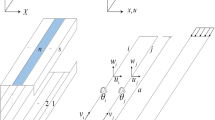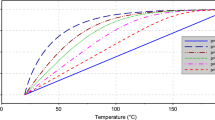Abstract
We present a numerical technique to model the buckling of a rolled thin sheet. It consists in coupling, within the Arlequin framework, a three dimensional model based on 8-nodes tri-linear hexahedron, used in the sheet part located upstream the roll bite, and a well-suited finite element shell model, in the roll bite downstream sheet part, in order to cope with buckling phenomena. The resulting nonlinear problem is solved by the Asymptotic Numerical Method (ANM) that is efficient to capture buckling instabilities. The originalities of the paper ly, first in an Arlequin procedure with moving meshes, second in an efficient application to a thin sheet rolling process. The suggested algorithm is applied to very thin sheet rolling scenarios involving “edges-waves” and “center-waves” defects. The obtained results show the effectiveness of our global approach.
















Similar content being viewed by others
References
Abdelkhalek S, Zahrouni H, Potier-Ferry M, Legrand N, Montmitonnet P, Buessler P (2009) Coupled and uncoupled approaches for thin cold rolled strip buckling prediction. Int J Mater Form 2(1):833–836
Marchand H (2000) Modélisation de la planéité en sortie de laminage des produits plats (Modelling flatness in flat rolling), Ph.D. thesis École nationale supérieure des mines de Paris
Hacquin A, Montmitonnet P, Guillerault J.-P. (1996) A steady state thermo-elastoviscoplastic finite element model of rolling with coupled thermo-elastic roll deformation. J Mater Process Technol 60(1):109–116
Abdelkhalek S (2010) Un exemple de flambage sous contraintes internes: Étude des défauts de planéité en laminage á froid des tôles minces, Ph.D. thesis École nationale supérieure des mines de Paris
Fischer FD, Rammerstorfer FG, Friedl N, Wieser W (2000) Buckling phenomena related to rolling and levelling of sheet metal. Int J Mech Sci 42(10):1887–1910
Fischer FD, Friedl N, Noe A, Rammerstorfer FG (2005) A study on the buckling behaviour of strips and plates with residual stresses. Steel Res Int 76(4):327–335
Rammerstorfer FG, Fischer FD, Friedl N (2001) Buckling of free infinite strips under residual stresses and global tension. J Appl Mech 68(3):399–404
Nakhoul R, Montmitonnet P, Potier-Ferry M (2015) Multi-scale method for modeling thin sheet buckling under residual stresses in the context of strip rolling. Int J Solids Struct 66:62– 76
Kpogan K (2014) Simulation numérique de la planéité des tôles métalliques formées par laminage, Ph.D. thesis, Université de Lorraine
Counhaye C (2000) Modélisation et contrôle industriel de la géométrie des aciers laminés à froid (modelling and industrial control of the geometry of cold rolled steels), Ph.D. thesis, Université de Liège
Roddeman D, Drukker J, Oomens C, Janssen J (1987) The wrinkling of thin membranes: Part i—theory. J Appl Mech 54(4):884–887
Abdelkhalek S, Montmitonnet P, Potier-Ferry M, Zahrouni H, Legrand N, Buessler P (2010) Strip flatness modelling including buckling phenomena during thin strip cold rolling. Ironmak Steelmak 37(4):290–297
Ben Dhia H (1998) Multiscale mechanical problems: the Arlequin method. C R Acad Sci IIB 326(12):899–904
Ben Dhia H, Rateau G (2005) The arlequin method as a flexible engineering design tool. Int J Numer Methods Eng 62(11):1442–1462
Ben Dhia H, Rateau G (2001) Mathematical analysis of the mixed Arlequin method. C R Acad Bulg Sci I 332(7):649–654
Philippe S (2009) Développement d’une formulation arbitrairement lagrangienne eulérienne pour la simulation tridimensionnelle du laminage de produits plats, Ph.d. thesis École nationale supérieure des mines de Paris
Büchter N, Ramm E, Roehl D (1994) Three-dimensional extension of non-linear shell formulation based on the enhanced assumed strain concept. Int J Numer Methods Eng 37(15):2551–2568
Simo J, Rifai M (1990) A class of mixed assumed strain methods and method of incompatible modes. Int J Numer Methods Eng 37:1595–1636
Zahrouni H, Cochelin B, Potier-Ferry M (1999) Computing finite rotations of shells by an asymptotic-numerical method. Comput Methods Appl Mech Eng 175(1):71–85
Bischoff M, Ramm E (2000) On the physical significance of higher order kinematic and static variables in a three-dimensional shell formulation. International journal of solids ans structures 37:6933–6960
Azrar L, Cochelin B, Damil N, Potier-Ferry M (1993) An asymptotic numerical method to compute postbuckling behavior of elastic plates and shells. Int J Numer Methods Eng 36(8):1251–1277
Tri A, Cochelin B, Potier-Ferry M (1996) Résolution des équations de navier stokes et détection des bifurcations stationnaires par une méthode asymptotique numérique. Revue européenne des éléments finis 5:415–442
Boutyour E, Zahrouni H, Potier-Ferry M, Boudi M (2004) Bifurcation points and bifurcated branches by an asymptotic numerical method and padé approximants. Int J Numer Methods Eng 60(12):1987–2012
Cadou JM, Potier-Ferry M, Cochelin B (2006) A numerical method for the computation of bifurcation points in fluid mechanics. Europeen journal of mechanics B: fluids 25:234–254
Cochelin B (1994) A path-following technique via an asymptotic-numerical method. Comput Struct 53(5):1181–1192
Cochelin B, Damil N, Potier-Ferry M Méthode asymptotique numérique. Hermes-Sciences, Paris
Tri A, Zahrouni H, Potier-Ferry M (2014) Bifurcation indicator based on meshless and asymptotic numerical methods for nonlinear poisson problems. Numerical methods for partial differential equations 30(3):978–993
Rateau G (2003) Méthode Arlequin pour les problémes mécaniques multi-échelles: Applications á des problémes de jonction et de fissuration de structures élancées, Ph.D. thesis, École Centrale de Paris
Guidault P.-A., Belytschko T. (2007) On the L2 and the H1 couplings for an overlapping domain decomposition method using lagrange multipliers. Int J Numer Methods Eng 70(3):322–350
Roddeman D, Drukker J, Oomens C, Janssen J (1987) The wrinkling of thin membranes: Part I—theory. J Appl Mech 54(4):884–887
Abdelkhalek S, Montmitonnet P, Legrand N, Buessler P (2011) Coupled approach for flatness prediction in cold rolling of thin strip. Int J Mech Sci 53(9):661–675
Bush A, Nicholls R, Tunstall J (2001) Stress levels for elastic buckling of rolled strip and plate. Ironmak Steelmak 28(6):481–484
Hibbitt K (2001) Sorensen, ABAQUS/standard user’s Manual, Vol. 1, Hibbitt, Karlsson & Sorensen
Abdelkhalek S, Zahrouni H, Legrand N, Potier-Ferry M (2015) Post-buckling modeling for strips under tension and residual stresses using asymptotic numerical method. Int J Mech Sci 104:126–137
Friedl N, Rammerstorfer FG, Fischer FD (2000) Buckling of stretched strips. Comput Struct 78(1):185–190
Acknowledgments
The authors wish to thank the French National Research Agency (ANR) ANR-11-LABX-0008-01, LabEx DAMAS, for its financial support and the partners of the ANR PLATFORM, under contract no. 2012-RNMP-019-07, (ArcelorMittal, CEA, CEMEFMINES-PARISTECH, Constellium, Ecole Centrale of Paris, INSA Lyon and Paul Verlaine university of Metz) for the authorization to publish this work.
Author information
Authors and Affiliations
Corresponding author
Appendix A: Details of asymptotic numerical algorithm
Appendix A: Details of asymptotic numerical algorithm
Asymptotic Numerical Method (ANM) is a technique for solving nonlinear partial differential equations based on Taylor series with high truncation order. It has been proved to be an efficient method to deal with nonlinear problems in fluid and solid mechanics [19, 21–24, 26]. This technique consists in transforming a given nonlinear problem into a sequence of linear ones to be solved successively, leading to a numerical representation of the solution in the form of power series truncated at relatively high orders. Once the series are fully determined, an accurate approximation of the solution path is provided inside a determined validity range. Compared to iterative methods, ANM allows significant reduction of computation time since only one decomposition of the stiffness matrix is used to describe a large part of the solution branch without need of any iteration procedure. First, the procedure allows expanding the unknown variables of the problem in the form of power series with respect to a path parameter a and truncated at order N . For the considered problem 6, we set:
The series thus formed is composed of N sequences of the unknown variables and with the initial state of the problem given for order 0. For simplicity, we assume that there are no forces applied on the boundary of the coupling domain. In addition, by considering any vector \((\cdot )^{j}_{i}\), j denotes an asymptotic order and i represents the 3D domain (i = 1) or the shell domain (i = 2). Substituting (12) into (6), we obtain the following linear problem for order 1:
Similarly, we can derive the following linear problem for order k (1 < k ≤ N)
To solve the system of Eqs. 13 and 14, an additional equation is needed. In this work, we introduce a condition similar to the arc-length type continuation condition:
where < ., > denotes the scalar product for two vectors.
For the continuation procedure, reader can refer to references [21, 25, 26].
Rights and permissions
About this article
Cite this article
Kpogan, K., Zahrouni, H., Potier-Ferry, M. et al. Buckling of rolled thin sheets under residual stresses by ANM and Arlequin method. Int J Mater Form 10, 389–404 (2017). https://doi.org/10.1007/s12289-016-1288-5
Received:
Accepted:
Published:
Issue Date:
DOI: https://doi.org/10.1007/s12289-016-1288-5




